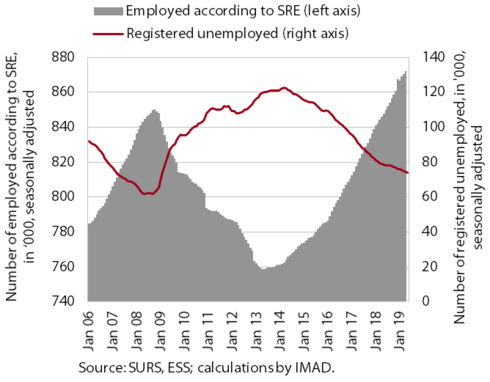Charts of the Week
Current economic trends from 17 to 21 June 2019: labour market, wages, slovenian industrial producer prices, residential housing price indices and business tendency
Employment is increasing further, mainly on account of the hiring of foreign workers, but also, to a somewhat lesser extent than in previous years, the hiring of the unemployed. Wage growth is strengthening. Property prices also continue to rise, while property sales are slowing amid limited supply. Economic sentiment is deteriorating further, but remains above the long-term average.
Labour market, April–May 2019

Employment continues to rise, albeit at a slower pace than in previous years. In the first four months of this year, the number of employed persons rose the most in manufacturing and construction. Labour shortages amid high labour demand continue to be reflected in increased hiring of foreigners, who already contribute more than two-thirds to total employment growth. The growth of employment is also due to the hiring of unemployed persons, but the number of unemployed is falling more slowly than in previous years given that the level of unemployment is already relatively low. At the end of May, 72,012 persons were registered as unemployed, 6.1% fewer than in the same period of 2018.
Wages, April 2019

Wage growth strengthened in the first four months of this year, in line with expectations. In the private sector, wage growth was – in addition to economic and demographic factors (good business results, labour shortages and thus upward pressure on wages) – also due to the increase in the minimum wage at the beginning of the year. Wages rose the most in administrative and support service activities, accommodation and food service activities, trade and manufacturing, i.e. the sectors with the greatest labour shortages and a high share of minimum wage recipients. In the public sector, wage growth mainly reflected strong growth in the government sector as a result of the higher valuation of most positions agreed at the end of last year, promotions and, to a lesser extent, the increase in the minimum wage.
Slovenian industrial producer prices, May 2019

The year-on-year growth of Slovenian industrial producer prices remained around 1% in May. Boosted by favourable developments in the Slovenian economy, price growth on the domestic market strengthen further, exceeding 2% year on year for the first time since August 2018. This was mainly due to the 15.1% higher prices in energy, gas and steam supply; prices of non-durable consumer goods were also higher year on year. The moderation of foreign demand has a negative impact on the movement of Slovenian producer prices on foreign markets, which were down year on year in May for the first time since September 2016, by 0.3%.
Residential housing price indices, Slovenia, Q1 2019

In the first quarter, the average prices of residential properties continued to rise, while the number of transactions dropped further amid limited supply. Following the acceleration in 2017–2018 and further growth in the first quarter of this year, prices were up 8.4% year on year. Strong growth arises from the increase in the prices of existing dwellings (up by one-tenth). The prices of existing family houses rose the most, but remained lower than before the crisis. The average price of new residential properties, which accounted for only 3% of all transactions, was somewhat lower than one year before, when it had increased strongly (by a quarter).
Business tendency, June 2019

Economic sentiment deteriorated slightly in June. The further decline was again mainly due to the lower confidence in the manufacturing sector, which recorded a deterioration in the assessment of the current situation and orders as well as the expected imports and production. Confidence in construction and service activities did not change after a period of decline and remained above the long-term average. Consumer confidence, which has been fairly stable in the last period, has also remained relatively high.
